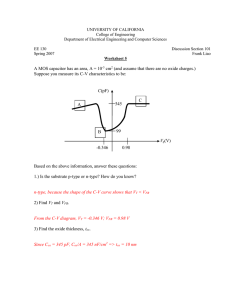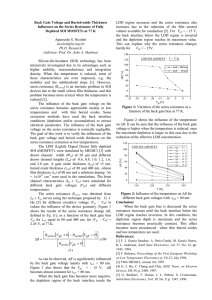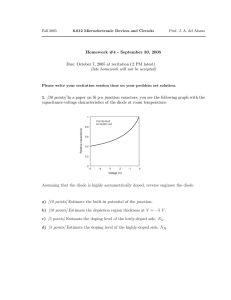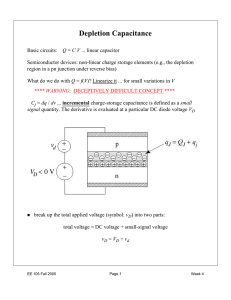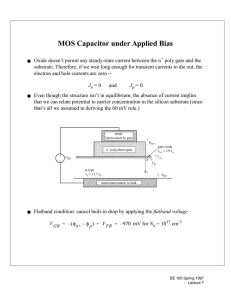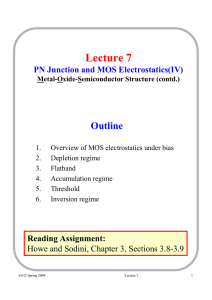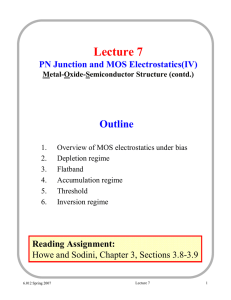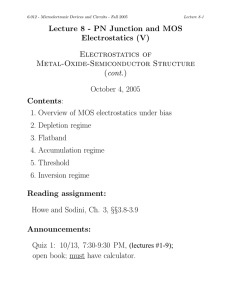Massachusetts Institute of Technology Department of Electrical Engineering and Computer Science
advertisement
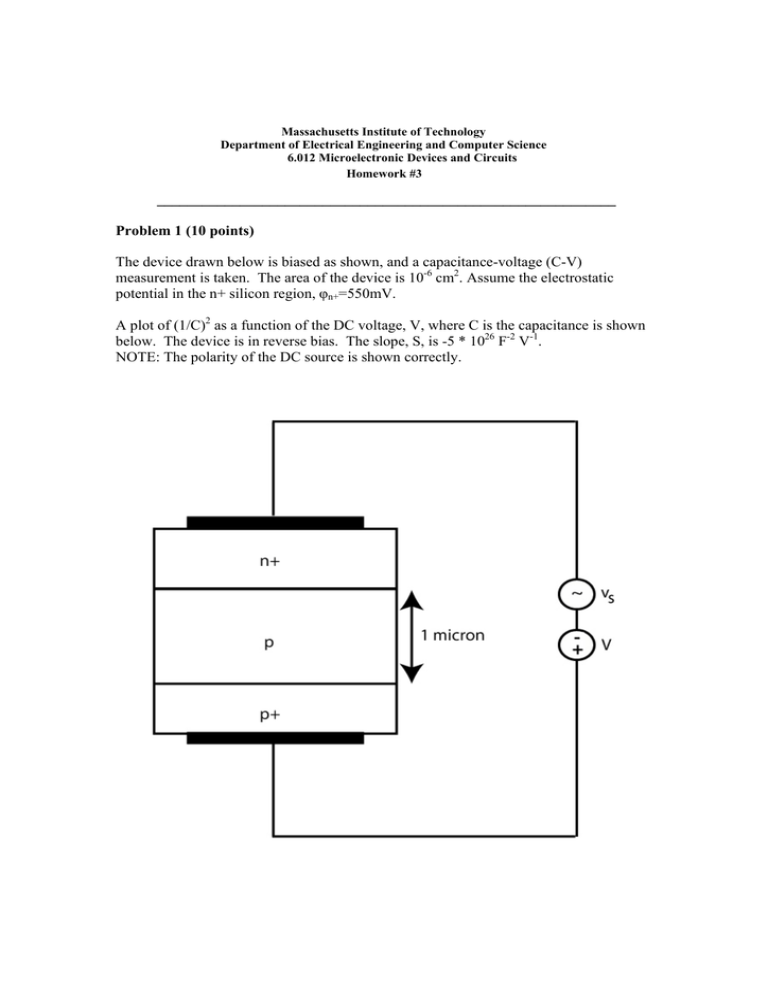
Massachusetts Institute of Technology Department of Electrical Engineering and Computer Science 6.012 Microelectronic Devices and Circuits Homework #3 _____________________________________________________________ Problem 1 (10 points) The device drawn below is biased as shown, and a capacitance-voltage (C-V) measurement is taken. The area of the device is 10-6 cm2. Assume the electrostatic potential in the n+ silicon region, φn+=550mV. A plot of (1/C)2 as a function of the DC voltage, V, where C is the capacitance is shown below. The device is in reverse bias. The slope, S, is -5 * 1026 F-2 V-1. NOTE: The polarity of the DC source is shown correctly. a) Derive an expression for the doping, Na, in the p-type region in terms of the slope S, shown in the plot, and other known parameters (e.g. constants like q, εSi, the device area). b) Assume now that Na is 1017 cm-3. Estimate the DC voltage V’ where the slope of the plot of (1/C)2 vs. voltage changes, as seen in the graph. Problem 2 (35 points) A metal-oxide-semiconductor (MOS) device is pictured below. Tox is 15nm. Assume φn+=0.55V, and that Na in the p region is 1016 cm-3. a) Find VFB, VTn, Xdo, φso. b) Find Xd,max. c) Sketch φ(x) for VGB=0, -2V, and +2V from the n+ gate through the oxide and into the silicon. Identify the regions of operation on the graph for each case of VGB. You don’t have to calculate φs for each case, but clearly show Xdo and Xd,max on the graph. d) Plot the gate charge QG, as a function of VGB, for VGB ranging from -2 to 2 Volts. Identify the regions of operation on the graph and show how the slope changes in each region. Also, plot the capacitance of the structure over the same range. Calculate and label Cmin and Cmax. Problem 3 (20 points) Shown below is a capacitance-voltage plot for an MOS capacitor. The gate is n+, therefore you can assume its potential is 550mV. The silicon dioxide thickness is 15nm, and the body is doped with some concentration of acceptors, Na. -0.97 VT VGB a) Determine the flatband voltage, VFB, on the C-V plot. b) Calculate VT. Hint: You will need to determine Na first. c) Specify the range of voltages where the MOS capacitor is in inversion, depletion, and accumulation. d) Now assume the gate is doped p+, so the potential of the gate is -550mV. Sketch the C-V, labeling VT and VFB. Problem 4 (5 points) It is sometimes useful in analog circuits to use a transistor biased in triode as a voltage controlled resistor. Use the following parameters to design a n-channel MOSFET with a resistance of 10KΩ. VTn= 1V VGS=1.5V VBS=0V µnCox=50μA/V2 a) If the device has a width of 10μm, what is the necessary length? b) What is the necessary width to get a 1KΩ resistor, if the length is 5μm? Problem 5 (10 points) Hafnium dioxide (HfO2, ε= 25) is an attractive replacement for silicon dioxide as a gate dielectric due to its high dielectric constant. Consider a p-channel MOSFET. The channel length, L = 1μm, the width, W = 10μm, the hole mobility is μp = 150 cm2V-1s-1 and the substrate doping is Nd = 1017cm-3. Assume the gate is p+ silicon, so its potential is -550mV. a) What thickness of HfO2 is needed for VTp = -0.5 V? b) Find the backgate effect parameter, γp for the hafnium dioxide gate insulator thickness from (a). c) If I=25μA, what is VSG? Assume saturation. d) What is the minimum drain voltage for saturation given VSG calculated in (c)? Problem 6 (10 points) Howe and Sodini – P4.2 Problem 7 (10 points) Howe and Sodini – P4.3 MIT OpenCourseWare http://ocw.mit.edu 6.012 Microelectronic Devices and Circuits Spring 2009 For information about citing these materials or our Terms of Use, visit: http://ocw.mit.edu/terms.

